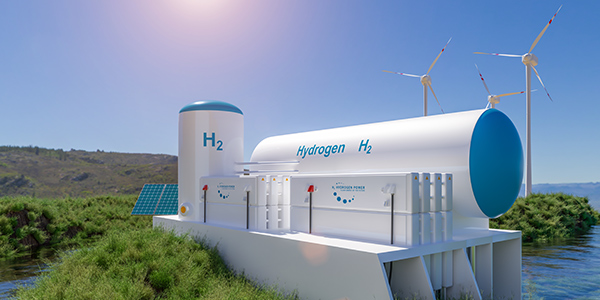National Grid is participating in research to determine how to convert existing gas networks to support hydrogen that could be used for home heating, Kristin Munsch, the utility’s director for regulatory and consumer strategy, said Wednesday.
Hydrogen is a versatile source of energy that presents the opportunity to use existing infrastructure to meet climate goals, Munsch said during a virtual panel event hosted by the Northeast Energy and Commerce Association.
Space and water heating is the second largest source of emissions in Massachusetts, according to data from the Massachusetts Clean Energy Center, and most New England buildings are currently heated by fossil fuels.
Large wind projects, such as those in the U.K. and Europe, are producing an oversupply of energy that can be used for hydrogen production, independent energy market researcher Brad Bradshaw said during the panel discussion. The stranded electrons can be monetized by powering water electrolysis to produce hydrogen, which can then be put in pipelines for things like steel manufacturing or blending with natural gas.
“It seems to meet a lot of challenges” related to Massachusetts’ climate goals, Munsch said.
Because hydrogen is not a new industry, it already has an extensive supply chain, Bradshaw said. Handling the storage and transportation of hydrogen is “done in a well-experienced industry and a safe, economical manner.”
Research is now focused on how to “pipe the hydrogen within homes safely and test [hydrogen] with different appliances,” he said.
“Several boilers are already manufactured around the world that take in 100% hydrogen to produce heat for homes, so it’s not really challenging,” Bradshaw said. “It’s just new.”
Excess solar and wind from grids in New York and Maine can be converted to hydrogen and transported cost effectively in high-capacity compressed tube trailers to places like Boston to help decarbonize the gas system, he said.
In the U.K., where the utility is headquartered, National Grid is researching different “flood rates” of hydrogen to a network of more than 100 residential buildings and commercial office spaces, Munsch said. The utility is learning from colleagues in the U.K. about what kind of pipes to use to transport hydrogen.
“The question now is how does it behave differently in our distribution systems,” Munsch said, as New England has “a lot of old pipes.”
National Grid has also partnered with the New York State Energy Research and Development Authority and Stony Brook University’s Institute for Gas Innovation and Technology to assess the impact of introducing hydrogen to infrastructure in New England.
In New York, National Grid has a proposal pending for a multiuse hydrogen production and utilization facility in collaboration with Standard Hydrogen Corp. The renewable natural gas produced will be injected into National Grid’s gas distribution system. The facility would also incorporate carbon capture, utilization and sequestration.
Research into hydrogen as a source of thermal energy is a “question of keeping all of our options open” for the anticipated increase in electrification of sectors such as heating and transportation, Munsch said.



